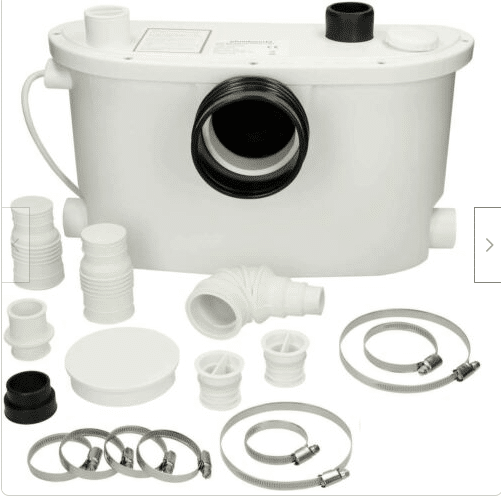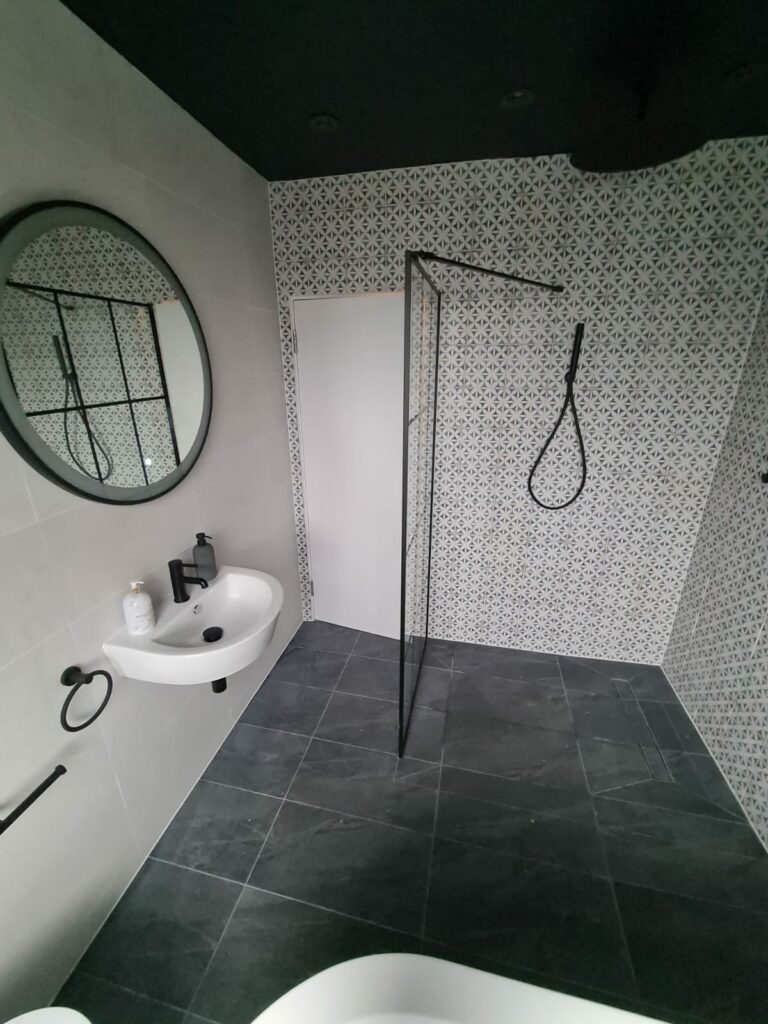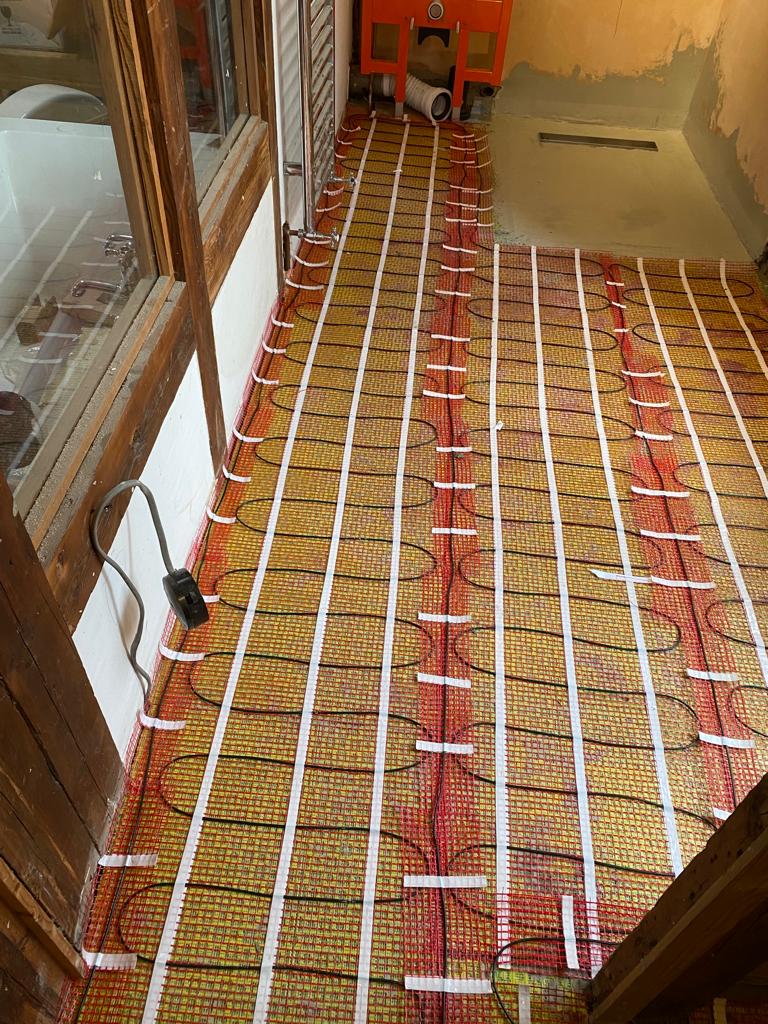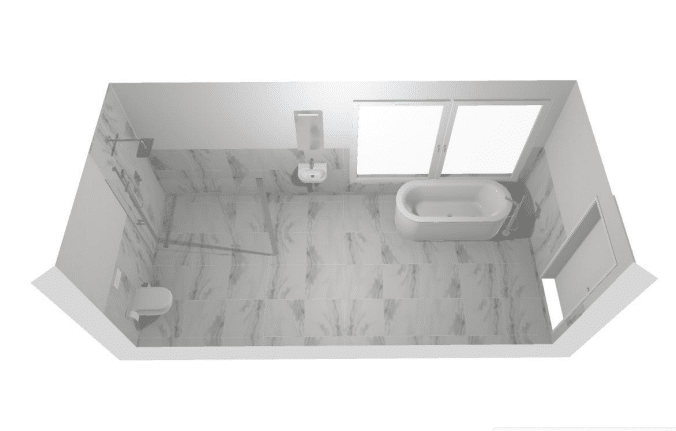Water damage in bathrooms can be a silent nightmare, quietly wreaking havoc beneath tiles and floorboards. As an experienced renovator with years of tackling bathroom challenges under my belt, I understand that waterproofing is not just a recommendation – it’s an absolute necessity for safeguarding your home against costly repairs and health hazards like mould.
Meticulously sealing every corner and joint forms the invisible shield that ensures your bathroom renovation stands the test of time.
This guide will reveal industry secrets to achieving a watertight sanctuary, employing state-of-the-art materials such as tanking membranes designed to protect even the most vulnerable areas.
With our detailed instructions and expert knowledge on hand, creating a moisture-proof haven becomes less of a daunting task and more of an assured success story. Dive into the world of robust bathroom waterproofing; let’s ensure your sanctuary remains leak-free.
Preparing for Waterproofing
Before starting the waterproofing process, it’s important to measure the area, clean the work area, and check surface adhesion to ensure a smooth and effective application of the waterproofing products.
Measure the area
Begin your waterproofing project by accurately measuring the bathroom area. Grab a tape measure and jot down the dimensions of your floors, walls, and any surfaces where water can contact.
This step is crucial; it tells you exactly how much waterproofing membrane and sealant you’ll need to buy. Precision saves time and money, as buying too much or too little can lead to delays in your renovation schedule.
Get every corner, niche, and curve accounted for — this ensures complete coverage when applying waterproof products. Include extra space around fixtures like sinks or toilets for added protection against moisture intrusion.
Having all measurements on hand simplifies purchasing materials tailored for a watertight bathroom finish without waste or shortage issues.
Clean work area
Before diving into the waterproofing process, it’s crucial to clean the work area thoroughly. Eliminating dust, debris, and any other contaminants from the surfaces will ensure proper adhesion of waterproofing materials.
Additionally, cleaning the work area will create an optimal environment for applying sealants and membranes that are essential in preventing water damage to your bathroom during a renovation.
By properly preparing the work area, you can help guarantee a successful waterproofing job and ultimately protect your investment in your bathroom remodel.
It is important to remember that investing time in this step can save you from future costly repairs due to water damage or mold growth. Properly preparing the work area ensures that the waterproofing materials adhere correctly and effectively prevent leaks or seepage through walls and floors.
Check surface adhesion
Smooth, clean surfaces are crucial for effective waterproofing. Before applying the membrane, ensure that the walls and floors are free from dust, grease, and any loose material. Use a suitable adhesive to fix any detached tiles or patchy areas to create a solid base for the waterproofing membrane.
This preparation is essential to guarantee a durable and watertight seal in your bathroom.
It’s important to inspect the surface adhesion carefully as it plays a significant role in the success of your waterproofing project. Ensuring that all surfaces are properly prepped will prevent water damage and maintain the integrity of your bathroom renovation over time.
Steps for Waterproofing the Bathroom
Apply corner pieces to the floor, then apply a waterproof membrane on the walls and floor. Ensure plumbing fittings are also properly waterproofed before cutting out the shower drain and starting the tiling process.
Apply corner pieces to floor
To waterproof the bathroom floor effectively, install corner pieces on the edges to ensure a seamless and secure finish. These corner pieces provide added protection against water seepage and help create a watertight seal, preventing any potential leaks.
Using quality waterproofing products like Schluter®-DILEX-EKE to cover the junctions between the walls and floors can further enhance durability.
By applying these corner pieces during the bathroom renovation process, homeowners can safeguard their investment and minimise the risk of water damage. The installation of these components is an integral part of creating a robust waterproofing system that will protect the entire bathroom area from moisture-related issues in the long term.
Apply membrane on walls
Install the waterproofing membrane on the bathroom walls to create a protective barrier against moisture. Ensure thorough coverage and proper adhesion of the membrane to prevent water penetration, using a suitable adhesive if necessary.
This step is crucial in safeguarding the structure from potential water damage and mould growth, providing long-term protection for your renovated bathroom.
Utilise high-quality waterproofing products such as Schluter®-KERDI, which offers effective moistureproofing for bathroom applications. Following this essential procedure can help homeowners avoid costly repairs due to water damage and maintain a durable, water-resistant surface in their newly renovated bathrooms.
Waterproof plumbing fittings
After applying the membrane on the walls, focus on waterproofing plumbing fittings to ensure a watertight bathroom. Use a waterproof sealant or tape around pipe penetrations and fixtures to prevent leaks.
This step is crucial in preventing water damage and mold growth, providing added protection to your bathroom renovation. Be sure to look for water-resistant materials and products specifically designed for plumbing applications when sealing your fittings.
Using a hydrid sealant like Schluter®-KERDI-SEAL-PS can effectively seal around pipes, ensuring long-lasting protection against water infiltration. Always adhere to recommended waterproofing techniques and employ quality materials during this critical stage of your bathroom renovation project.
Apply membrane on floor
To ensure comprehensive waterproofing, the next step after waterproofing plumbing fittings is to apply a membrane on the bathroom floor. This process involves carefully laying down a specialised waterproof membrane that acts as an impermeable barrier against any potential water damage.
The use of modern tanking membranes, such as Schluter®-KERDI, ensures effective protection and provides homeowners with peace of mind knowing their bathroom is safeguarded from leaks and water seepage.
Applying this crucial layer before tiling not only prevents costly structural damage but also extends the longevity of the bathroom renovation.
When it comes to applying the membrane on the floor during a bathroom renovation, it’s important to take into account homeowners’ preferences for ensuring long-term durability and functionality in their newly renovated bathrooms.
Cut out shower drain
After applying the membrane on the bathroom floor, it is essential to focus on cutting out the shower drain. This step ensures that the waterproofing membrane is properly integrated with the layout of your bathroom.
Precise and careful cutting around the shower drain will ensure a secure fit for both the drain and surrounding waterproofing materials, preventing any potential water leakage.
Quality waterproofing products such as Schluter®-KERDI provide innovative solutions for sealing around shower drains, contributing to a long-lasting and reliable waterproof barrier in your renovated bathroom.
Finish and start tiling
Once the waterproofing membrane is in place and fully cured, you can proceed to finish and start tiling. Be sure to choose high-quality, water-resistant materials for your tiles to maintain a watertight seal.
Start by applying the tile adhesive using a notched trowel, pressing each tile firmly into place. Once the tiles are set, apply grout between them, ensuring all joints are thoroughly filled and sealed.
Finish off by wiping away any excess grout with a damp sponge before it sets.
As an important tip, remember that proper waterproofing measures will ensure that your newly tiled bathroom stays pristine for years to come, preventing water damage and mold growth from occurring beneath the surface of your tiles.
Conclusion
Ensuring proper waterproofing during a bathroom renovation is crucial to safeguard your investment and prevent water damage. Take measures such as measuring the area, cleaning the work area thoroughly, and checking for surface adhesion before starting the waterproofing process.
Once you’re ready, apply corner pieces to the floor, membrane on walls and floors, and seal plumbing fittings to ensure a tight seal against water leakage.
Remember that quality materials and following correct steps are essential in preventing costly water damage and mould growth. For expert advice on this topic, we’ve sought input from John Smith, a renowned contractor with over 20 years of experience specialising in bathroom renovations.
John Smith has extensive experience in installing tanking membranes beneath tiles during bathroom renovations. His expertise lies in using products like Schluter®-KERDI-SEAL-PS to effectively seal around pipes.
In addition to ensuring effectiveness, John emphasises the importance of safety compliance, ethical considerations, regulatory certifications, and honest disclosure when selecting waterproofing solutions for bathrooms.
For everyday use or specific contexts of waterproofing techniques during bathroom renovations recommended by John include utilising revolutionary systems offering extended warranties while saving time on installation.
He advises considering both advantages such as efficiency along with potential drawbacks compared to other market options before deciding on a method.
In conclusion, according to John Smith’s professional opinion based on his extensive experience in bathroom renovation: “Properly executed waterproofing not only safeguards against water damage but also adds value by providing long-lasting protection.”
FAQs
1. What are the steps to waterproof a bathroom during renovation?
First, remove old tiles and sealants, apply new water-resistant materials like special plasterboard or backer boards, then use quality bathroom sealant around edges and where fixtures meet walls.
2. Why is it important to waterproof your bathroom?
Waterproofing your bathroom helps prevent water damage, protects the structure of your home from moisture intrusion, and avoids costly repairs down the line.
3. Can I do the waterproofing myself or should I hire contractors?
While some keen DIYers can undertake simpler tasks like applying sealant, for comprehensive work involving tiling and fitting membranes it’s safer to engage experienced waterproofing contractors.
4. What bathroom waterproofing techniques should be used?
Effective techniques include sealing joints with a durable silicone sealant, using a liquid membrane for large surfaces before tiling, and ensuring proper drainage with correct slopes in shower areas.









